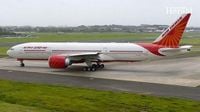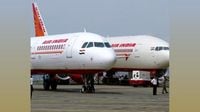New Delhi, April 3 – Air India has officially begun the Boeing 777-300 ER refresh as part of its ambitious $400 million aircraft retrofit program, starting with the first legacy aircraft completed in Singapore. This milestone marks the beginning of a large-scale modernization plan that will eventually cover all 13 legacy B777-300 ERs by the end of 2025.
The term “heavy refresh” refers to substantial interior upgrades without a full retrofit. For these B777-300 ER aircraft, the heavy refresh includes brand-new carpets, replacement seat covers, refreshed cushions, and repairs of broken or outdated seats. These changes, although not a complete retrofit, significantly improve passenger comfort and cabin aesthetics for long-haul operations.
Initially, the full retrofitting of legacy B777s was planned for 2023. However, global supply chain constraints and component shortages delayed the process. As an interim solution, Air India opted for this heavy refresh model, which can be completed faster and provides a significant quality upgrade until retrofits are possible.
The first refreshed Air India Boeing 777-300 ER was updated in Singapore, a process that took around 50 days. According to airline officials, all 13 legacy B777-300 ER aircraft will undergo this treatment by the end of 2025.
Air India has plans to initially deploy the refreshed aircraft on domestic routes for brief testing. Later, they will serve on ultra-long haul routes including Toronto, Vancouver, San Francisco, Chicago, Newark, and New York. These routes typically last more than 14 hours and are currently dominated by the B777 fleet.
Air India’s fleet currently includes 198 aircraft, with 67 wide-body planes. Of these, 13 are legacy B777-300 ERs, 27 are B787-8s, 7 are B787-9s, and 6 are A350-600s. Some of these legacy B777s still feature first-class cabins, which are gradually being phased out as the airline modernizes its seating configurations.
According to MD & CEO Campbell Wilson, all legacy wide-body aircraft—including both B777s and B787s—will be fully retrofitted by mid-2027 under a comprehensive $400 million plan. The full retrofit includes complete cabin redesigns, upgraded entertainment systems, seating changes, and inflight connectivity.
Parallel to the wide-body refresh, narrow-body aircraft like the A320neo fleet are also being upgraded. The first retrofitted A320neo has already returned to service, and all 27 of these aircraft are expected to be completed by Q3 2025.
The delay in retrofitting is largely due to global supply chain challenges. These include shortages in aircraft engines for narrow-body planes, delays in seat production, and limited availability of fuselage components. As Wilson aptly described, “We are victims of the circumstances as is every other airline.”
While the refreshed B777s will fly domestic initially, they are designed to return to ultra-long haul operations, especially for high-demand sectors. This transitional strategy ensures minimal downtime and continuous fleet optimization.
The Air India Boeing 777-300 ER refresh is more than cosmetic—it is a critical step in reclaiming the airline’s international competitiveness and meeting the expectations of global travelers. With increased comfort, better aesthetics, and improved functionality, Air India is setting the stage for its broader transformation under the Tata Group’s ownership.
In April, the first legacy B787 will be sent out for full retrofit. This signals the start of phase two in Air India’s fleet modernization. Air India is also balancing its existing fleet with leased aircraft: 6 B777-300 ERs from Etihad Airways and 5 B777-200 LRs from Delta Air Lines. These aircraft are expected to serve as stopgaps while the legacy fleet undergoes upgrades.
As Air India begins the Boeing 777-300 ER refresh, the focus is on bridging the gap between outdated cabins and a future-ready airline experience. This refresh is just the beginning of a wider transformation plan that seeks to redefine Air India’s position in the global aviation landscape. With supply chains expected to remain tight until at least 2027, the airline’s adaptive strategy—beginning with heavy refresh and phasing into retrofits—is both practical and promising.
Passengers can expect better comfort, newer interiors, and improved service on long-haul flights as the upgrades roll out progressively through the year.


